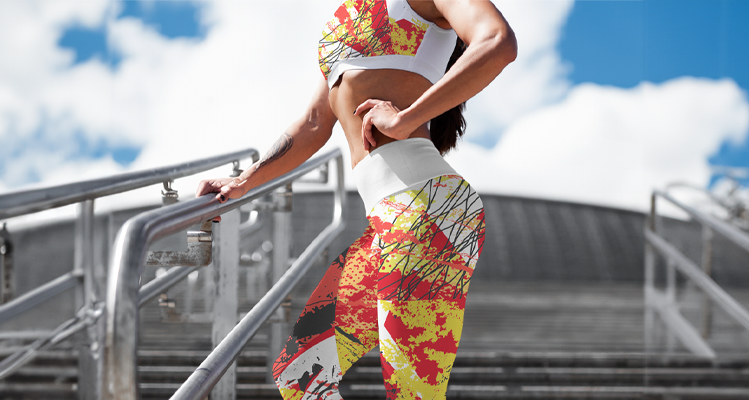
All About Activewear: From Sublimation Paper to Sustainable Fabrics
In activewear, everything is meticulously designed to combine comfort, style, durability, and sustainability. In this article, we explain why sublimation paper and eco-friendly fabrics are not a fleeting trend in the process, but rather two determining elements in creating these garments.
Sublimation printing is one of the types of digital textile printing used to customize fabrics. It differs from direct printing because images and designs are initially printed with sublimation inks on sublimation paper, also known as transfer paper, and then transferred from this paper to the fabric through heat and pressure.
In this method, the inks become gaseous when heated, penetrate the paper fibers, and return to a solid state when cooled. The paper with visual motifs and the fabric are then placed in a heat press, and the ink is transferred from the first to the second.
Sublimation is a very versatile technique that, when done with the right equipment and materials, provides unparalleled color intensity and vivacity, high sharpness of images and designs, and greater durability of prints.
At the fabric level, it proves ideal for synthetic/polyester-based fabrics, allowing the creation of pieces with lower costs, various textures and shines, and resistance to heat and abrasion.
In sublimation printing, we can have the best printer, the best inks, and the best fabrics, but the quality of the work is seriously compromised if the sublimation paper does not guarantee the best transfer of visual motifs.
The results of a poor choice of paper are colors different from the original, imprecise lines, stains, ink inconsistencies on the surface, and premature wear of the prints. To avoid all this, decal® launched the Winner sublimation paper with a coating specially formulated to control the amount of ink that is absorbed and retained on the paper surface.
The transfer to the fabric is facilitated and smoothed by the release of ink in the right amount, achieving the desired colors and saturation. Ink consumption is also significantly reduced, lowering printing costs and the ecological footprint. Besides all this, this sublimation paper does not warp during printing, and drying is quick.
Learn more about this decal® novelty here.
Functionality is fundamental in activewear sportswear, and textile materials must meet the main needs of users. The most common choice is technical fabrics such as polyester, Lycra, and nylon because they are lightweight, breathable, and dry quickly.
Polyester stands out among them and is widely used due to its high capacity to absorb moisture, regulate body temperature, and allow unrestricted movements.
Activewear is no longer solely associated with a healthy lifestyle with good sports practices and has taken an active role in affirming good environmental practices. Ecology has joined the demands of those who wear these garments, and everything is evaluated, such as raw materials and cultivation and production processes.
Sustainable fabrics gain more and more followers and range from organic cotton to recycled cotton or polyester fibers, through hemp, bamboo, and recycled PET bottles. Pineapple fiber fabrics (Piñatex), mushroom (MycoTEX), and wood pulp from reforestation trees (Tencel / Lyocell) are also a reality.
In cultivation processes, those involving fewer chemicals, such as pesticides or synthetic fertilizers, are sought. Regarding production, the most suitable is the one that consumes less water and energy and minimizes the consumption of natural resources, pollution, and waste.
In the world of sustainable fabrics, recycled fabrics contribute doubly to reducing the carbon footprint of the textile industry. On the one hand, they reduce the need for virgin raw material and, on the other, give new utilities to waste.
In activewear sportswear, it is possible to combine environmental benefits with the benefits of polyester and achieve garments that are friendly to the environment and users. This is what greentex, a partner of decal®, did with its sustainable textiles that combine ecology, design, soft touch, and comfort.
The fabrics are created from recycled polyester, generating zero water waste and respecting the commitment of the European Green Pact so that all fabrics are recycled or recyclable by 2030.
Learn more about this partnership here.
The particularities of activewear sportswear distance it from conventional fashion. It is not enough to "look good" or "be cute". It should make garments the best ally of athletes (professional and amateur), and if we also add sustainability and aesthetics to it, it's perfect.
All of this is achieved when decal Winner® sublimation paper is used in sublimation printing that gives vibrant colors to greentex's sustainable fabrics. The results are immediate and lasting, making this combination a sports fashion that is not at all fleeting as it has proven that it is here to stay.




